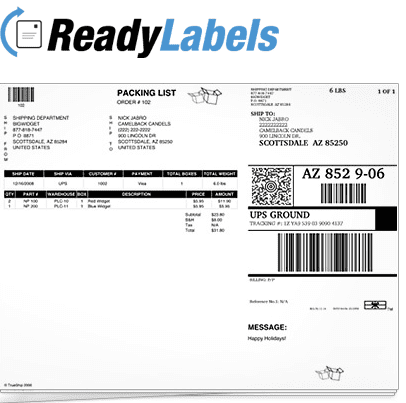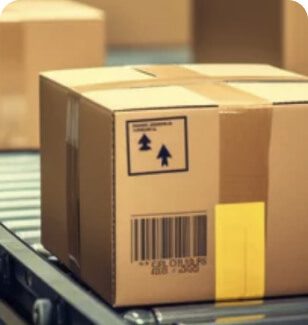Ecommerce Shipping: The Definitive Guide

Once your packages are shipped, what happens next is entirely beyond your control.
The ecommerce shipping method that you choose is the very backbone of your entire operation. If you utilize a shoddy shipping option, customers can become easily disgruntled with package delivery delays, receipt of damaged items, lack of tracking information, shipping errors and other hindrances.
With plenty of technologically enhanced options available to you for hosting your own ecommerce store these days, just about anyone with a computer and the desire to sell products online can hop on the e-retailer bandwagon.
Most people don’t give too much thought about what happens to their packages after they ship them out to their customers. And plenty fail to understand or appreciate the complexities that are involved in ecommerce shipping, and the relationship it has between you and your customer.
Make sure you are apprised of the ins and outs of ecommerce shipping and fulfillment so you can provide exceptional service to your customers, from order to delivery. This definitive guide can serve as the starting point to your future e-retailing successes.
“In 2025, competent shipping departments are adopting a multi-carrier approach utilizing USPS, UPS, FedEx and even regional carriers. It is not only about saving money; flexibility is essential. With multiple carrier options available, delays from one carrier are less concerning.
The ultimate key is having access to a shipping solution that integrates with all your carriers and offers real-time rate shopping and unique rate options. Don’t wait until it’s too late. Begin setting up test shipments now, and familiarize yourself with deadlines and additional fees each carrier imposes to gain a competitive advantage.” – Read Article on Forbes
Ecommerce Shipping Options
Choosing the carrier (or carriers) that you want to use for your ecommerce shipping needs can be tough. Each has its own prescribed rates, rules, regulations and fees that can make it a difficult choice for you. The rates fluctuate a lot, too, as was seen in the recent announcements by FedEx and UPS regarding 2015 rate increases, piggybacked by the USPS announcing late 2014 rate decreases.
You do have plenty of options, however. We’ll cover what these entail so you can make the most advantageous choice for shipping ecommerce. The shipping prices that you charge will have a direct impact on the sales that your ecommerce store generates. To get a better idea of how this correlates, have a look at this infographic we created below.
Less is More
When considering which packaging option is best for your ecommerce shipping and fulfillment needs, it’s best to think outside of the box – quite literally. The adage of less is more makes perfect sense here. Using less packaging will reduce your bottom line and help cut down on your carbon footprint, too.
What’s more, many times you may not need a box to send a smaller item. For example, if you are shipping smaller, lighter items that don’t need protective padding or a box, you can use bubbler mailers or coffee bags, to reduce your packaging cost substantially.
You can also still pursue a strong brand approach, one that’s truly customer-facing, with bubble mailers and coffee bags by simply adding a personal touch. Things like custom printed labels and stickers of your brand can be eloquently affixed to really make your packaged goods stand out.
A company called Sticker Mule offers custom ecommerce stickers that are perfect for doing this. They are available in all sorts of different shapes, sizes and colors, and can make for the perfect addition to any ecommerce mailer or small box that’s unbranded.
We’ve all opened packages that had that special look and feel before (as noted above in regard to using your packages to advertise to customers, create that “wow” effect and really drive home your brand name. A simple addition such as branded stickers like these can really go a long way in driving home your message to each consumer who receives a shipped item from your online store.
How You Package & Ship Will Vary
You’re going to need options with different packages, and of all sizes and shapes. As an e-retailer, your packaging needs will wager on what products you are selling. It’s therefore advisable that you get connected with a packaging supplier as soon as possible.
Getting the best rates on shipping with your elected packaging provider can be tricky business, if you don’t know what the shipping rates are in advance. A supplier called TrueShip Supply offers a wide assortment of boxes, bubbler mailers, scales, printers, scanners, shipping labels and even software to meet your ecommerce shipping needs.
What is interesting about TrueShip Supply is that you are able to see what the shipping rate will be for each box, and before you buy it. These rates coincide with the special shipping rates offered to their customers via their exclusive Flat Rate Select – an easier, more affordable way for shipping ecommerce via USPS.
One of the greatest factors in any online retailer’s bottom line easily is their shipping cost. With options like this, where you can determine what your most commonly shipped packages will cost to ship, and well before you ship them out, it’s easier to factor in your bottom line. What’s more, it also enables you to offer your customers an economical yet speedy shipping option, so you can earn more sales and improve your conversion funnel.
The “Unboxing Effect”

In the early ages of the ecommerce world, consumers didn’t really think much of the packaging that safely housed their ordered goods. Most people were just eager to receive their parcel so they could make use of their purchase.
These days, how you package something can mean the difference between your store standing out or blending in with the rest. A wise approach is to consider packaging like a customer-facing advertising option. It should be part of your marketing plan.
Several prominent e-retailers have embraced this concept, and it’s something everyone can borrow a page from. Online retailer Mimitos has become rather famous for their packaging/branding endeavors, prompting satisfied and wowed customers to actually film themselves opening their orders. The high quality boxes that they send to customers demonstrate how you can achieve a lasting brand impression, and are worth the extra monies invested to win over long term customers.
As you can tell from the picture provided above left, the package arriving in the mail is an experience in itself. It puts the brand name center stage, luring shoppers into the cadence of an appealing, affluent and unique design, one that’s augmented by the profundity of branded packaging.
It’s important to consider consumer reaction when you package your goods. A quick look on YouTube tells us how many viral unboxing videos are out there, and we can only imagine how they can influence your sales when people start raving about how amazing your packaging looks. Certainly, offering enticing packaging such as this will cost a bit more; but it can almost be viewed as a form of advertising that helps you also attract more customers in the long run, too.
Offer Free or Cheap Shipping
One of the surest ways that you can increase sales at your online store is by offering free shipping. As the above infographic demonstrates, 87% of customers have stated that they’ve abandoned a shopping cart due to the high cost of shipping. Furthermore, 76% of shoppers polled have stated that free shipping was the most important reason for them not abandoning a shopping cart.
You might be wondering how you can possibly ever offer free shipping and afford to do it without breaking the bank. The good news is that you do have several viable options that you can consider here, options which can offset the cost that you encumber by offering free shipping to your customers.
- Adjust your listed product prices to accommodate for offering free shipping.
- Incorporate the cost of shipping into your profit margins to always factor them in.
- Offset the cost of shipping by adding a portion of that to the product price and absorb the rest.
- Think of free shipping just like you would an advertising budget – it takes money to make money.
- Consider mandating a minimum order amount for customers to get free shipping.
- Get connected to a discount rate on shipping via providers like Flat Rate Select, which connects you to low-cost and instant shipping discounts via USPS Priority Mail on packages up to 20-pounds.
A study that was conducted by E-tailing Group found that customers are far more responsive to free shipping being offered than a discount on a product being offered. Another related study compared customers being offered a $10 product discount to them being offered $6.95 in free shipping, noting that the offer of free shipping was still more effective.
Don’t forget that shipping prices and shopping cart abandonment are directly linked. Studies have found that the cost of ecommerce shipping is one of the most important factors in getting customers to close the sale. Be aware that what you charge for shipping will also factor into your long term sales, and should be a part of your ongoing strategy.
Use Real-Time Rates from Carriers
You can also look into real-time carrier rates from the major shipping providers. Some shopping carts offer direct integration with the major carriers, which means that you can stream shipping options and prices for your customers. This not only allows you to offer more shipping options, but it also enables your customers to decide which shipping option they want to use.
Offer Flat Rate Shipping
One of the most popular ecommerce shipping options is the flat rate option. According to recent polls, 78% of all shoppers select the standard economy ground shipping option as their preferred choice, which has an average of a 10-day delivery time. Utilizing carrier flat rate discounts, you can offer affordable shipping.
Overview of Ecommerce Shipping Options
You’ve got quite a few ecommerce shipping options that you can consider offering at your online store. As stated above, unless you can always offer free shipping, it’s best to present customers with a wide array of choices, so they can choose which option best fits their needs and their budget.
Several options are available to you that can help you decide which ones you should prominently feature at your online store. These include, FedEx, UPS, USPS and DHL.
Determining Your Rates
Shipping rates are based upon a number of related factors, which can and do vary between the major shipping carriers. Make sure you measure factors that include the following: package size and weight, what country you are shipping to or from, tracking of the package, added insurance and upgraded and expedited shipping options.
Some shipping carriers in the U.S. are limited to where they can deliver, too. For example, FedEx and UPS can’t deliver to P.O. boxes or U.S. military installations, whereas the USPS can. You should take these factors into consideration when comparing which ecommerce shipping option is the best for your online store.
Generally speaking, FedEx and UPS are ideal choices for shipping larger, heavier packages because of the dimension-based shipping discounts they offer. But the USPS is ideal for shipping smaller, heavier packages, especially via Priority Mail, due to the less expensive and zone-based shipping options and speedy delivery.
While the major carriers do not allow shipping software prodivers to compare rates in the actual software, there are ample and free services online that let you instantly compare rates between all carriers, in real-time. Good advice is to consider using one of these services, or to find a convenient desktop plug-in that you can use, so you can know what the best rate is before you start sorting your orders and printing your shipping labels for fulfillment.
Variances Between Carrier Rates
Keep in mind that all carriers will charge varying rates when shipping ecommerce. But, USPS uses set pricing for all of their services, saving you the worry about costly fuel surcharges and other common fees. Whereas rivals UPS and FedEx can tack on surcharges and various fees that can increase your cost of shipping. Take a look at this USPS vs. FedEx, UPS Price Change Comparison Chart that was created by our discount shipping partner, Endicia, for further clarity.
Understanding that carrier rates can and will vary is important in you getting the lowest rate to ship your packages. In addition, it’s always wise to keep your ears open by setting convenient Google Alerts about rate changes from major carriers. This way, you can be informed well ahead of time, and can make any necessary adjustment to your shipping prices well before the rates increase.

Can You Offer Free Shipping?
A lot of retailers offer free shipping these days to lure customers in and close more sales. Free shipping has been linked to more conversions and decreased shopping cart abandonment rates, too (see the infographic below). While the decision to offer free shipping is one that you you should carefully wager, a lot of retailers are offering it and have noted increased sales. Take a look at these Nine Stores That Are Killing It By Offering Free Shipping.
While some retailers simply can’t afford to offer free shipping, many can and do. A good option to consider here is to offer free shipping on orders that exceed a certain dollar volume. Factor this average dollar volume into your profit margin, and you will see that free shipping may reduce your average profit, but will serve to strongly reinforce more future sales. In the end, volume wins the free shipping game, which is why so many retailers are now offering it when the order amount exceeds a certain cap.
Shipping Insurance
Things can sometimes get damaged when they are shipped. So you need to also factor this element into your game plan. According to recent studies, 20% of all products are returned from online purchases due to the fact that they arrive damaged.
You’ve got a number of options that you can consider with shipping insurance. This should be something that you especially look into for your larger priced items – and can be something that you choose to offer to customers as an added amenity to help secure the sale.
Be careful when selecting third-party shipping insurance providers. While there are plenty of legitimate players in the game, you’ll want to inform your customers that any shipping insurance claims have to be made via this third-party, something that you can add to the packing slip by providing the claims information, should the customer opt to buy this value added service. Also, you can mark these services up and tack on a small profit each time the insurance is purchased by the customer.
Tracking Numbers
You will also want an integrated system for managing your tracking numbers. There are a number of software solutions that you can explore that can let you track packages in real-time and provide customers with updates. ReadyShipper shipping software, for example, lets you send instant updates to customers that include the tracking number, comments and ship status.
TrueShip also gives you the option to see all your tracking and shipping information online with ReadyCloud. This makes it easy for everyone in your company to get a real-time look at all of your ecommerce shipping activity from any internet-enabled device. It’s ideal for instant visibility, tracking and reporting, on-the-fly.
If you do not use an automated software system to provide tracking numbers, things can get messy. The result often is that you are left to spend the labor to manually copy and paste tracking numbers to update customers. When you consider stores that have large daily order volumes, it makes a lot more sense to automate this process by using reliable, efficient and innovative software to do the busy work more accurately instead.
Customs
If you plan on offering international shipping, you will want to make sure you are prepared to manage the facilitation of the required forms and documents. You can find these online or at the nearest post office. The forms advise the officers at customs about what is in the package, what it is worth, and whether or not it was a gift or an outright purchase.
You will want to check with your shipping carrier to ensure that you include the proper forms and documentation. If you ship a package internationally that does not include these, it could be held up in customs or even shipped back. You will want to make certain that your shoppers are well aware of this fact. Be sure to inform them that you have no control over how long customs can hold packages.
Most multi-carrier shipping systems, like ReadyShipper, will automatically generate all of the necessary custom forms, for all your selected shipping carriers, when you process and print your shipping labels. Typically, this simply requires that you import or enter your product information with your shipment information. Using a software solution such as this, you can expedite your international fulfillment process exponentially, and can also help to improve on shipping accuracy, too.
Customs Declaration
International shipping can be tricky, as each country has its own limitations, restrictions and mandates. Since there are so many different countries that you can prospectively ship to, it’s advisable that you familiarize yourself with the most popular international shipping destinations. While you will always be able to use the carrier of your choice, this related UPS guide can help you get a head start, and is packed with a ton of helpful information.
Lowering International Shipping Costs
There is a service that can help you reduce your international shipping costs while streamlining the process of getting your packages cleared through customs. APC Postal Logistics connects users to the lowest international ecommerce shipping rates.
Their parcelConnect service uses the post office that your shoppers will receive packages at to speed up delivery and reduce shipping cost. They also help you tackle any documentation along the way, while connecting you to advantageous discounts on shipping in the process.
Bear in mind that international shipping is a beast in and of itself. You have to factor in the shipping cost, the customs and declarations and much more. Doing so can be a real mind-bender, which is why a lot of domestic-based online retailers prefer to only ship to the lower 48 states. Carefully assess your situation to assure that international delivery is an option that you can afford to offer.
Shipping Labels

To add a true personal touch to your packages, you will want to assure that you use professional shipping labels. You will also want to make certain that the labels that you consider using are compatible with all major U.S. carriers (FedEx, UPS, USPS). This also means that you will need labels that work with your chosen shopping cart, too.
A product called ReadyLabels is compatible with all U.S. carriers. The labels come in reams that contain 200 sheets. They are made on die-cut 8.5”x11” sheets of paper with a perforated comment card and packing list, and a 4”x6” peel-out shipping label.
These labels can give you an advantage because they can be printed from any standard laser or inkjet printer; no thermal printer is needed. They also save you time with fulfillment because you won’t have to print a packing list from one system and a shipping label from another, and then spend time matching them up to fulfill orders.
Remember that you can only sell as many items as you are able to ship in a day. Any method that you can introduce to reduce your fulfillment time while not compromising accuracy will help you grow your business. Using a smart label system is a great way to create a short cut with this process, one that enables you to ship more items while not compromising on accuracy or the customer experience.
Do Fulfillment Services Make Sense?
You can also, alternatively, consider using a fulfillment warehouse to get your ecommerce orders shipped to your customers. Warehouses can automate the shipping process for you. But they are not without their associated pros and cons, either. You can gain some advantages by using a fulfillment warehouse to ship your ecommerce goods. One benefit is reduced ecommerce shipping cost. Since warehouses provide fulfillment for lots of stores, they can sometimes connect you to discount shipping rates.
Since many warehouses are directly integrated with the major shipping carriers, this might result in you getting lower ecommerce shipping rates. Another perk is that generally there is a faster shipping time. This is because regionally and strategically located fulfillment warehouses can enable you to assure faster delivery to your customers for less; but these are typically only a viable option for larger ecommerce stores.
Fulfillment warehouses are not without their associated downsides, though. One reason is because a fulfillment warehouse will not typically go to the same lengths to assure branding with your packaging as an in-house fulfillment center would. If you are trying to make a name for yourself with packaging that wows, this is not a veritable option. They can also incur added operational cost because fulfillment warehouses will charge you a monthly fee, and a laundry list of other fees, to provide their services. When you factor all of these fees into the big picture, it could affect your bottom line too much to be feasible.
Managing Product Returns
Another element of ecommerce shipping that you will have to factor in are online product returns. According to recent studies, over one-third of all products that are ordered online will be returned by the consumer. In about 65% of all instances, the returns are not the fault of the consumer, either.
One study about online product return rates found that 81% of shoppers want hassle-free, no-questions asked returns to be offered (like Zappos offers). Another related study found that over 80% of shoppers want an easy and convenient method of making returns.
Returns are just part of the ecommerce game, and there are some things that you can do to reduce the rate of online product returns. Helpful starter suggestions include featuring plenty of images that are in high resolution and that include multiple angles, zoom-in options and even video. Be sure that your content is description and up-to-date, with important sizing information and charts for apparel (you can also look into sizing apps, too).
Things like electronics are better demonstrated when shown in use (a flat screen TV mounted to the wall in a living room, for example).
- Make sure that your online store clearly states your returns policy upfront, including the date that products can be returned from purchase and any associated fees.
- Offer low-cost online product returns to increase sales and pad your profits.
- Make returns easy by enabling customers to initiate them online at your website.
- Add the incentive of an in-store credit versus refunds to reduce the cost of returns.
Do not foolishly overlook the power of a lucrative and generous returns policy. Doing so could mean that you see customers bounce away from your store to another store that offers a similar product with a more convenient returns policy. Your returns policy says a lot about your online store, and it’s ultimately one of the most influencing aspects on whether or not a customer closes the sale or abandons the shopping cart.
Have a look at this helpful infographic about how you can better manage online product returns and actually earmark lucrative profits by doing so.
You’re In Control
Managing your ecommerce shipping operation will not be without its challenges, that’s assured. The smartest approach is to take your time when creating your plan-of-action to assess the specific needs of your business. Bear in mind that this is a trial and error scenario that has no perfect solution from the get-go.
By identifying your ecommerce shipping goals and forming your strategy early on, you can prevent many missteps along the way. Make sure that you reevaluate your process every few months, so you can amend, update and improve it along the way.
As your business needs change, your shipping strategy will also need to evolve. By utilizing this type of critical preplanning in advance, you can be as best prepared as possible for the future successes – and pitfalls – that you are sure to encounter along the way.
Ecommerce Shipping Guide in Review
- Use marketable packaging: How you market your product is a big way that you can separate yourself from other online retailers. In our given example, Trunk Club pulls this feat off to perfection. Shoppers are enamored with the packaging that they receive, creating a viral social sharing sensation that’s referred to as the “unboxing effect,” where shoppers are wowed when they receive their package and become eager to open it and view the contents.
- Options for packaged goods: You have plenty of options that you can explore for packaging your goods. A good rule of thumb is to keep these packaging options in par with your shipping resources. Some packaging options will make sense for lowering your bottom line and reducing shipping cost while speeding up the delivery time, making for happier customers along the way.
- Use less packaging: Try to reduce your packing to a feasible minimum. This helps you both reduce your carbon footprint and cut down on shipping cost along the way. There are plenty of creative ways that you can still send packages that exude the “wow” effect while also curbing how much packaging that you are using while exploring options with discount packaging.
- Ecommerce shipping options: Study the demographic of your customers and customers as a whole that prefer to shop online. Make sure you are meeting their needs with expedited shipping options and economy shipping options. Doing so will ensure that customers are more likely to buy products from you because they can get the shipping price and delivery options that they desire.
- Feature free or reduced cost shipping options: Studies have shown the shoppers prefer to use economy shipping options, with the vast majority wanting free shipping. You can work out the logistics of cost in this and factor these elements into your bottom line to help counter the cost you’d have to absorb in favor of increasing consumer sales across the board.
- Real-time carrier rates: You can add plugins to your site that will show the customer the real-time carrier rates. This gives the customers the choice to decide which shipping option and rate is best for them and their purchase.
- Feature flat rate shipping options: Most customers are content to wait for the standard ground delivery option. Make certain that you are featuring this as a choice for them when they are checking out.
- Overview of ecommerce shipping options: Make sure you are well aware of all the ecommerce shipping options that you have. This will let you decide which carriers and rates are going to best serve your bottom line.
- Determine your ecommerce shipping rates: These will vary based upon where you are sending the package, what size and weight the package is, whether it’s an international or domestic shipment and what carrier that you are using. Familiarize yourself with these aspects so you can ship smarter.
- Carrier rate variances: Realize that each shipping carrier is different. Only the USPS really uses set rates, which also can increase from time to time as they adjust their budget. In short, one carrier’s rate may be better for shipping certain items, whereas another carrier’s rate may be better for shipping others.
- Improving profits from ecommerce shipping: Use the simple chart that we provided above to learn how you can factor whether or not there’s actually a profit margin that can be earned from charging from shipping. Be careful, however, so that you are still in par with what your competitors are offering, or you could detract from sales by doing so.
- Ecommerce shipping insurance: Explore your options with insurance for packages. One method is to offer the customer an upgrade free to add insurance. Another method is just include it as an added amenity that protects you if packages are delivered damaged.
- Customs and declarations: If you plan on shipping internationally, make sure you are familiar with how customs and declarations work in each country that you plan on shipping to. This includes duties, declarations, forms, taxes and so forth.
- Reducing international shipping costs: Find a partner that can help you get your goods shipped internationally while cutting down on the cost of shipping at the time. This will better enable you to offer worldwide shipping to attract more sales.
- Shipping labels: The labels that you use matter, and can either help you with your fulfillment process or cost you time and money in the form of lost man hours. Make sure you are adequately prepared for fulfillment by having an efficient labeling and fulfillment system in place that’s both accurate and cost effective.
- Pros and cons of warehouse fulfillment: Compare and contrast the pros and cons of using warehouse fulfillment versus self-fulfillment of your outbound orders. You may find that one makes more sense than the other for your bottom line and with sustaining and improving customer service.
- Handling online product returns: Understand that returns happen, and that there’s nothing that you can do to prevent them. But your online product returns policy can make a huge difference in future sales, customer service, satisfaction, loyalty and retention.
What You Should Do Now
Here are 3 ways ReadyShipper X can help you instantly cut shipping costs, keep delivery promises, and scale fulfillment without adding headcount:
Schedule a Demo – See how ReadyShipper X combines on-premise speed with cloud flexibility to ship your orders faster and cheaper, delivering the speed customers expect at costs that protect your margins.
Start Your Free Trial of ReadyShipper X (No CC Required) – Get up and running in minutes with instant access to multi-carrier rate shopping, smart automation, and enterprise features.
Try ReadyCloud at No Cost – Why manage shipping and returns separately? Get ReadyShipper X, ReadyReturns, and more in one unified platform for faster fulfillment, fewer headaches, and happier customers.
Share On:









